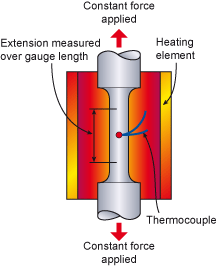A creep test is a type of mechanical test used to measure the deformation of a material under a constant applied load over time. Creep testing is typically used to evaluate the long-term mechanical properties of materials that are subjected to high temperatures and loads, such as metals and ceramics.
During a creep test, a sample of the material is loaded with a constant force and its deformation is measured over time. The load is typically applied along the longitudinal axis of the sample, and the deformation is usually measured in the same direction. The test is usually conducted at elevated temperatures and the results are used to study the material’s behaviour under conditions of long-term, sustained loading.
There are different types of creep test, such as uniaxial creep, where the load is applied in one direction, and multiaxial creep, where the load is applied in multiple directions. The results of a creep test are typically presented as a creep curve, which shows how the deformation of the material changes over time, and can be used to determine properties such as the creep rate, creep strength, and creep ductility of the material.

Importance of Creep Test
The importance of creep testing lies in its ability to evaluate a material’s long-term mechanical properties under high temperatures and loads. This is especially important for materials that are used in high-temperature applications such as power generation, aerospace, and petrochemical industries.
Knowing a material’s creep behaviour is vital for the design and safe operation of components that are exposed to high temperatures and loads for extended periods of time. For example, in power generation, creep properties of materials used in steam turbine blades or nuclear reactor components are crucial to ensure safe and efficient operation over their lifetime. In the aerospace industry, the knowledge of creep behaviour of materials is important to predict the lifetime of components such as jet engine turbine blades, which operate at high temperatures and loads.
Furthermore, creep testing also plays an important role in the development of new materials and in the optimization of existing ones. By understanding how a material behaves under high temperatures and loads, engineers and materials scientists can improve the properties of a material to make it more suitable for specific applications.
In summary, creep testing is essential for the safe and efficient operation of high-temperature components, and for the development and optimization of new materials.

Ankit Sharma is the Chief Editor at Uptu Khabar. He is passionate about new age digital marketing tools and their integration with the AI.